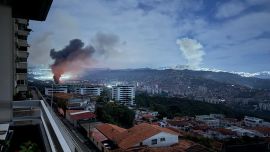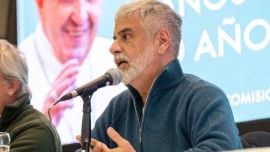So much we do not know about the novel coronavirus (not even what to call it with Covid-19 and SARS-CoV-2 competing with various less technical and more insulting descriptions) – hence the need for the overkill of extended lockdown – but that is not the only area of ignorance.
On March 23 the government announced the IFE emergency family income for various “vulnerable sectors” totalling an estimated 3.6 million households, only for over 12 million to step up to the plate, of whom 7.85 million were accepted for registration (over 60 percent of them irregularly employed, the main target group). These huge discrepancies led Labour Minister Claudio Moroni, appearing before the Senate Labour Committee at the start of the week (via videoconference, of course), to admit: “How little we know about this labour universe” – a twilight zone between the formally employed and welfare plan recipients.
This invisible universe has grown in silence during the last four decades to outnumber the visible in the pre-pandemic workforce – seven million in the underground economy as against just over six million registered workers in the private sector. And even adding public-sector employees (3.8 million) to the latter, the registered remain a minority if the self-employed (3.7 million) are added to the former – just under 10 million as against 10.7 million with that majority half divided into almost equal quarters of unregistered labour and the self-employed (a category increasingly characterised by pedlars and marginal odd jobbers rather than middle-class professionals with only about a third working formally within the system). Even before the pandemic the projection of this balance was negative because over 60 percent of those aged under 25 have no regular employment with a high job turnover in a world where youth unemployment is a global problem – the concept of apprenticeship now sounds almost mediaeval with the speed of technological change.
A workforce in flux because these gradually negative trends unfolded along with an also gradual longer-term future perspective of robots and automation eating up jobs as we know them but the terrifying velocity of this pandemic in the last five weeks accelerates everything, bringing the future much closer to the present. Estimating job losses in the last month at 45,000, Moroni is optimistic that the final total will be under a million but even this should not be seen as a mere five percent of the workforce but as 15 percent of all real jobs. Yet any meaningful forecast of job losses either here or in the world is clearly impossible at this stage.
At regular intervals analysts deplore the fact that almost half of Argentina or over 20 million people (including those 3.8 million state employees) depend for their monthly cheques on the taxes paid by the six million but this analysis does not belong to a column on the Labour Ministry, strictly speaking. Time to proceed to that, starting with the minister.
With the possible exception of Justice Minister Marcela Losardo, who also goes back to the presidential baby steps in public life at the Insurance Superintendancy in the first term of the Carlos Menem presidency (1989-1995), nobody in this Cabinet is an older friend of Alberto Fernández than his contemporary Claudio Omar Moroni, (just eight months younger at 60), who has been rewarded for this friendship with the Labour Ministry, traditionally a core area in any Peronist government. Moroni is not a trade unionist but a lawyer who has held various important bureaucratic posts, heading AFIP tax bureau (very briefly in 2008 with his exit around the same time as his friend, then-cabinet chief Fernández), the ANSES social security administration with its vast budget (also very briefly, 2007-2008) and SIGEN comptrollers (2004-2007) after kicking off along with fellow-lawyer Alberto Fernández at the Insurance Superintendancy, which he also came to head (1995-1998 and 2002-2004). In general, a somewhat colourless bureaucrat with no personal details likely to add any spice to this column.
Last week’s topic was the Social Development Ministry as the epicentre of the main scandal of the day, about which we said: “Most people would guess it to be a Peronist creation and would guess wrong” (it was in fact a military junta creation, surprisingly enough) – most people would probably make an identical guess about the Labour, Employment and Social Security Ministry and this time they would be right. A Labour and Pensions Ministry was established in 1949 by Juan Domingo Perón, thus promoting a secretariat of the same name which had been created for him by the 1943 military junta. Its predecessor was a National Department of Labour, created during pre-democratic Argentina in 1907 as a somewhat belated reaction to rising industrialisation and trade unionism (as in many countries, it was the printers who formed the first trade union back in 1857 while the 20th century started with the 1901 formation of the FOR A, the anarchist-led predecessor of today’s CGT, which began life in 1930). The Arturo Frondizi presidency changed the name to Labour and Social Security in 1958 while the Juan Carlos Onganía dictatorship dissolved the ministry altogether in 1966. It was restored as simply the Labour Ministry in 1971 with Menem later padding out the title to Labour and Social Security in 1989. The brief 1999-2001 Alliance administration rebranded it as the Labour, Employment and Human Resources Ministry under Patricia Bullrich but the ministry has had its present name since 2002 – apart from the 15 months preceding last December when Mauricio Macri demoted it to a secretariat under the Production Ministry.
There have been 46 ministers in the 65 years of the ministry with Carlos Tomada (2003-2015) by far the longest-lasting, followed by Jorge Triaca (almost six years between his two terms, the first starting in 1989 and the second ending in 2018). Only two of these ministers – Radical Antonio Mucci (lasting only four months) in 1984 and José Armando Caro Figueroa (1993-7) – made any serious bid to modernise industrial relations while Patricia Bullrich’s confrontational but largely sterile approach led to her being dubbed “the only man in the Cabinet.”
Only the first word of the Labour, Employment and Social Security Ministry has any meaning, famously calling compulsory conciliation, for example, since its job description limits it to vaguely helping to define the aims of social security (administered by ANSES, which Moroni has also headed) while it does not actually employ anybody apart from its staff of less than 2,000 (last year’s figures). But the mission impossible of defending employment against the pandemic is likely to make it a hot seat in the months and years to come.



















Comments